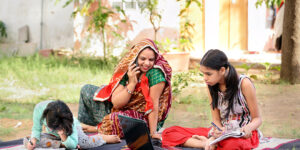
Internet connectivity in India is on the rise with several government initiatives that have been taken to bring about a digital transformation in the country. While the aim of these initiatives is aimed at strengthening rural internet connections, how effective have the efforts been?
Has internet speeds in rural areas been able to match that of urban India? Can an internet bonding router revolutionize rural internet connections? Find out as we make comparisons between rural and urban India based on internet connectivity.
The volume of internet users
 Believe it or not, rural India has more internet users than urban India. As of 2019, the number of active internet users in rural India was 227 million, which was 10% more than that of urban India. This statistic can be attributed to the following factors:
Believe it or not, rural India has more internet users than urban India. As of 2019, the number of active internet users in rural India was 227 million, which was 10% more than that of urban India. This statistic can be attributed to the following factors:
- Easier availability of mobile phones
- Efforts on higher internet penetration in rural India
- Reduced costs of mobile internet
- Government initiatives like Digital India
Penetration
 Although rural India has more active internet users than urban India, internet penetration in rural India remains significantly low in rural areas. Studies suggest that internet penetration in rural India is just 29.2% compared to over 65% of the top 8 metro cities of India. This suggests that although internet access is on the rise in rural areas, a majority of rural India is still untouched by it.
Although rural India has more active internet users than urban India, internet penetration in rural India remains significantly low in rural areas. Studies suggest that internet penetration in rural India is just 29.2% compared to over 65% of the top 8 metro cities of India. This suggests that although internet access is on the rise in rural areas, a majority of rural India is still untouched by it.
Age distribution
 As of 2019, the following was the distribution of internet users in urban and rural areas across India, by age group:
As of 2019, the following was the distribution of internet users in urban and rural areas across India, by age group:
- 12-15-year-olds constituted 12% in urban and 15% in rural India.
- 16-19-year-olds construed 14% in urban and 21% in rural India.
- The age group of 20-39 years constituted the percentage of internet users in both rural and urban India, at 54%.
- Above 40 years, urban India had 19% as compared to rural India’s 10% active internet users.
Internet speed
 Average download speed in India can be as low as 1 Mbps.
Average download speed in India can be as low as 1 Mbps.- In urban areas, the average download speed can be 15 Mbps with mobile internet, and around 100 Mbps with a broadband internet connection.
This is suggestive of the fact that rural India lacks the proper infrastructure that is needed to experience truly high-speed internet.
Mode of internet connection
The primary mode of internet connection is increasingly shifting towards broadband in urban areas of India. On the other hand, rural India is still largely dependent on mobile internet due to a lack of proper broadband facilities.
One thing to note here is the fact that the cost of spectrum is significantly higher in India, as compared to the rest of the world. This is why the major internet service providers have not found it attractive to make investments in the spectrum. The little bit that has been invested in has not totally dripped down to the rural areas.
Best alternative
 Barring institutions and workplaces, the general urban household doesn’t need a considerable replacement for their broadband internet routers at present. However, for institutions, businesses, video streamers, gamers, and others whose livings primarily rely on high-speed internet, an internet bonding router can prove to be the best alternative.
Barring institutions and workplaces, the general urban household doesn’t need a considerable replacement for their broadband internet routers at present. However, for institutions, businesses, video streamers, gamers, and others whose livings primarily rely on high-speed internet, an internet bonding router can prove to be the best alternative.
In rural India, VSAT communication can effectively reduce the internet issues that are currently prevalent. However, the associated costs can prove to be too high for the population to afford.
This is why an internet bonding router can be the best solution. An internet bonding router can offer better internet stability and connectivity at all times, even in bad weather conditions and remote locations. This, penetrating the rural areas of India with internet bonding routers can revolutionize internet usage in rural India.
Zifilink has already ventured into the rural parts of India, bringing unimaginable internet speeds and stability to areas that had never experienced an internet browsing experience of that level. With continued efforts, there are promising hopes that rural India’s internet connectivity will soon match that of India’s urban areas. Become a part of this change. Visit Zifilink to learn more.

 Average download speed in India can be as low as 1 Mbps.
Average download speed in India can be as low as 1 Mbps.

About The Author: Deepak
More posts by Deepak